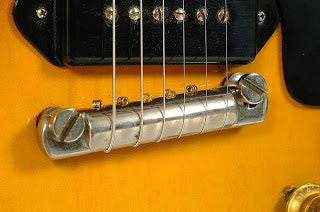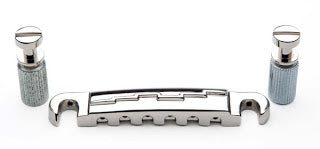Wraparound Bridge/Tailpiece
Share


This classic piece of hardware designed by Ted McCarty is still my all time favorite bridge if it's done right. The wraparound bridge/tailpiece from the '54/55 Gibson Les Paul offers a simplicity and functionality that is hard to match. It provides a firm seating for the strings, allowing the player to adjust intonation and string height as needed, and yielding an incredible union between the strings and body, resulting in excellent tone and sustain.
The Gibson Les Paul was introduced in 1952 and featured two P-90 single coil pickups, and a one-piece, 'trapeze'-style bridge and tailpiece, with strings that were fitted under (instead of over) a steel stop-bar.
In '54 the trapeze was replaced by Ted's "Wraparound Bridge/Tailpiece" which improved tone and sustain greatly and made string damping possible. THIS is the version I love even though it only ran for less than 2 years when the Custom was introduced in '55 with the now famous "tune-o-matic" bridge and the stoptail was moved backwards to anchor the strings. It was originally intended to string the strings the same way, over the tailpiece and on to the bridge but most players feed the strings in from the back. Some players, like Billy Gibbons (and myself) will tell you that all Les Pauls sound better with the strings being fed in from the front and wrapped over the tailpiece as it was intended.

The wraparound was used on all the cheaper Gibson (and some Epiphone) models like Les Paul Juniors, Specials, Melody Makers etc and SG equivalents through the 1960's. It was even used in a slightly different design on Gibson basses from the late 50's and 60's. In the mid 50's it was given a slight makeover with added intonation bars to help with non wound G strings being introduced on lighter string sets but these were still a bit hit and miss with some gauges.
In more recent years there have been many "intonatable" versions made with saddles but these don't sound the same as the original bar. If the bridge is put in the right place to start with these are exceptional bridges. They have a sustain and tone unmatched by ANY OTHER bridge system. There is something about all the string tension being ON the bridge that's anchored directly to the body that makes them vibrate and lock in with the body timber giving a tone like no other system. This is probably why PRS have always used them on everything up to their top of the line models and one of the reasons why those early Les Pauls and Gibson Jr's and Specials sound SO GOOD !!
